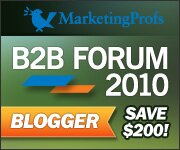Notes from the first two sessions today at MarketingProfs B2B Forum. Again, all slides/presentations are at www.marketingprofs.com/events/11/handouts.
Session 1: Getting Strategic with Your Brand
Lois Brayfield
Three things:
Brand defined: The perception customers have of your product or service.
B2B or Business to Institute: Forget that. You are selling to people with real minds, real problems, and people that are maybe afraid of their job security. (Business to Person mentality)
History has changed, we are in a new era. “The economy stinks.” – CNN
The consumer is in control. It used to be linear – used to have a big funnel of prospects, but now loyalty is in jeopardy. They can Google your name once, and the funnel increases. What does that mean? We have to change our way of thinking as it relates to the brand.
Do you know if people would rather Google a word or do they want to take your call? Open their mail?
All about customer experience – all of these touch points influence that.
We used to have a hard time monetizing the customer experience – managing this experience is paramount.
Those companies who actively manage the customer experience are twice as likely to exceed their profit targets.
What is the new customer face that is different?
You’re selling to a business, but they are individuals as well.
Todays customer has more choices than ever before, but less time to choose.
Here’s the problem: We are talking about the wrong stuff! We don’t understand true brand essence. You better say something that matters. Oh, and by the way? You only have two seconds.
You have to stand apart as a brand.
Cars have a differentiator – all brands need one simple truth to own.
In this day and age, you have to have a quality product, great customer service and added value.
Finding a differentiating brand benefit
Must be important to the customers
You are uniquely suited to deliver it
Your competitors are not addressing it
Always keep in mind the Trifecta: The customer, company and your competition. Focus on customer.
How do you get to know your customers
Visit your customers
One on one interviews
Take pictures
spend time on the phone and listen in
Speak with the field
Livers Bronze
Industry magazine ads
Industry catalogs
Company newsletter
Company catalog
Embracing our brand:
Research and data
Box stuffers
Design
Catalogs and emails
Products
Revised Tag lines
Session 2: Social media and the impact on lead generation and sales
How do we take all the things people wax poetically about and turn it into leads?
Share Case Studies
Share Tools
Share success (CALL BS IF YOU THINK IT IS!)
The Art of the Conversation
What happens after you initiate the conversation? You have to have the ability to track the lifecycle of conversations.
Top of the Funnel issue: Getting found.
The more lottery tickets you have, the better chance you have to win.
If you plan to use social media for branding, just buy a freakin’ print ad.
The more pages that you have indexed in Google, the more monthly leads brands get. (Check out graph in preso)
Focus on Top 100 Search Rankings – ranking in a position where people can find you.
Blogs that generate more interesting content
Companies who don’t blog: 9 leads, companies that did had 15. (1,400 customers from Hubspot survey)
Become a vertically integrated publisher as a B2B company.
3 rules of corporate blogging:
Blog like you are the best trade magazine in your industry (Content creation)
Connect posts with your SEO strategy (you need to be able to connect to lead generation – CALL TO ACTION)
Get everyone inside and outside your company to contribute
Getting found:
Keywords in Tweets (talk about indexing)
Participate/start industry chats
Monitor
Write guest blog posts to build links
Use Websitegrader.com and SEOmoz.com to optimize on page SEO
Give your landing pages the opportunity to rank in search
Understand lead and traffic segmentation – look at what is driving the traffic
Hubspot data – segment your social sources conversion rates (can help define your content and where you should spend time.)
How do you define a lead: When someone converts through a channel.
Google Analytics is great when you have the time to devote to it; feed into SalesForce
We make sure we look at where the opportunities are created, where our LinkedIn groups are created, looking at ones that are devoted to different topics.
Manage to track all things, whether its from Social media sites, bing terms, all funnel in through ActOn and SEO processes
Using technology to your advantage: Make sure you know scopes, SEO is not a technology. What are different ways you can create?
It Takes a Village: Sales and marketing has to be clear.
Not only have we trained all our sales force on LinkedIn, but positioned it as not a resume but a resource.
Make sure everyone is using their actual name in the profile
In your title, they have COMPANY NAME (A Cyber Security Company) in every person’s title
Put company information in the summary, not in the position (above the fold)
LinkedIn Groups
Try to answer questions, be active with groups
If you can’t spend the money on Act-On, and do a lot of work in Google Analytics (Advanced segmentation)
Email is a huge driver, LinkedIn drives a lot of leads




